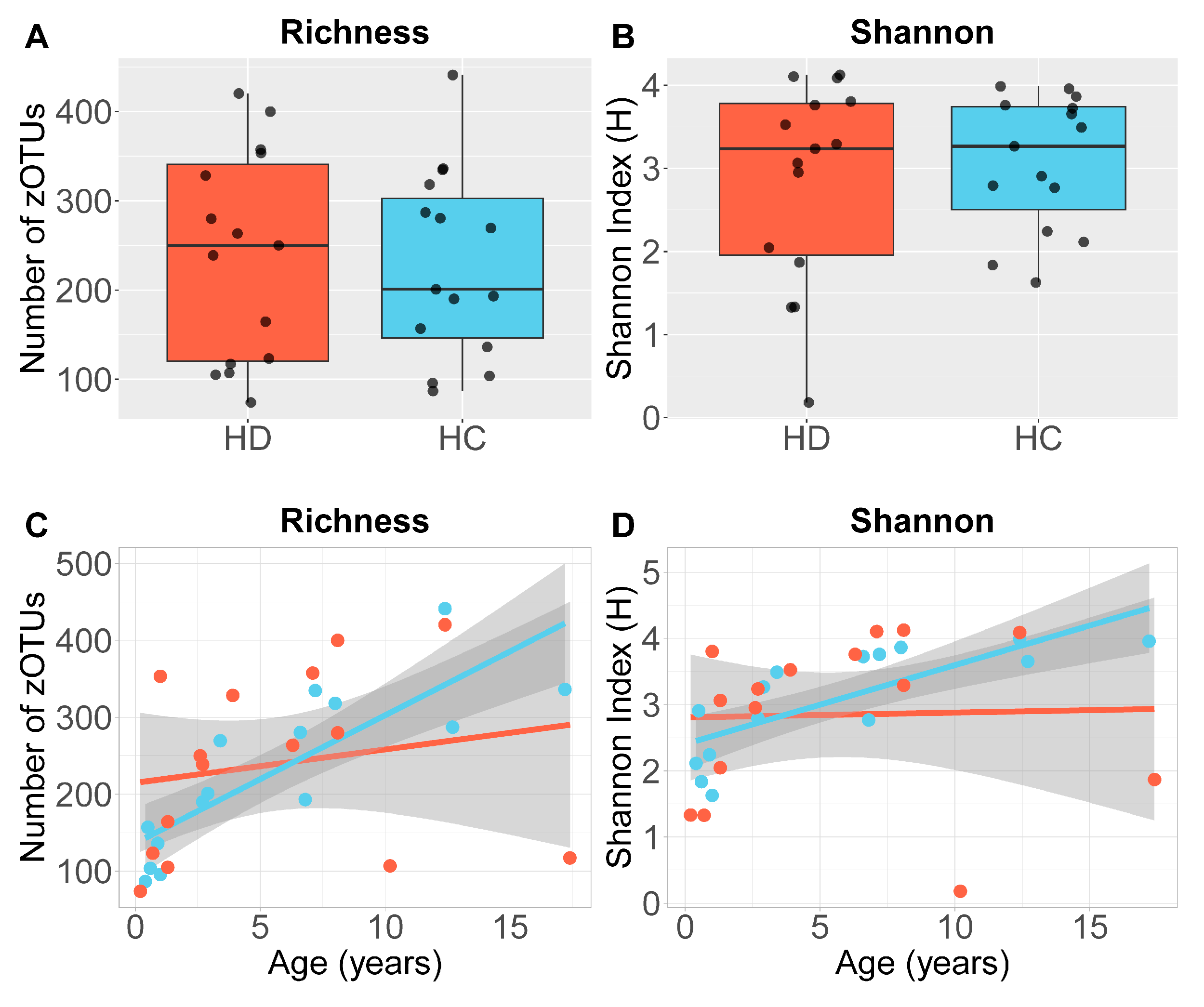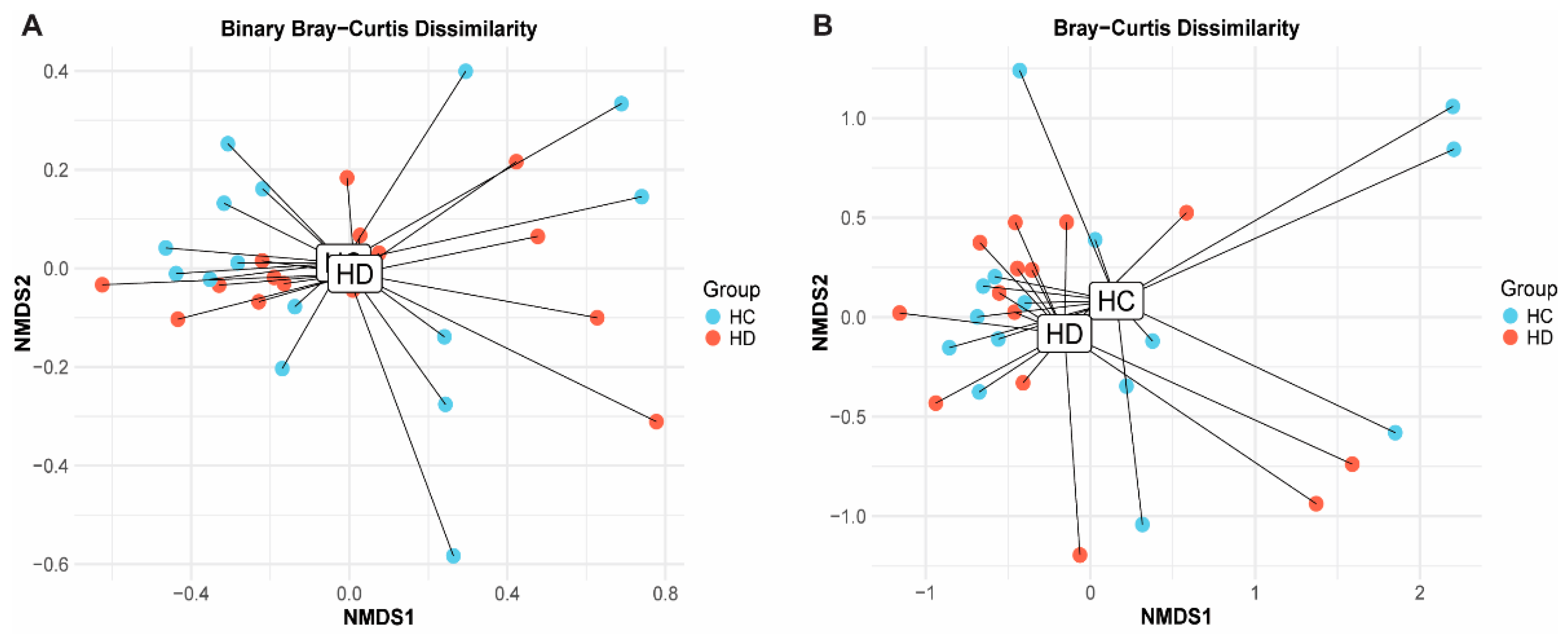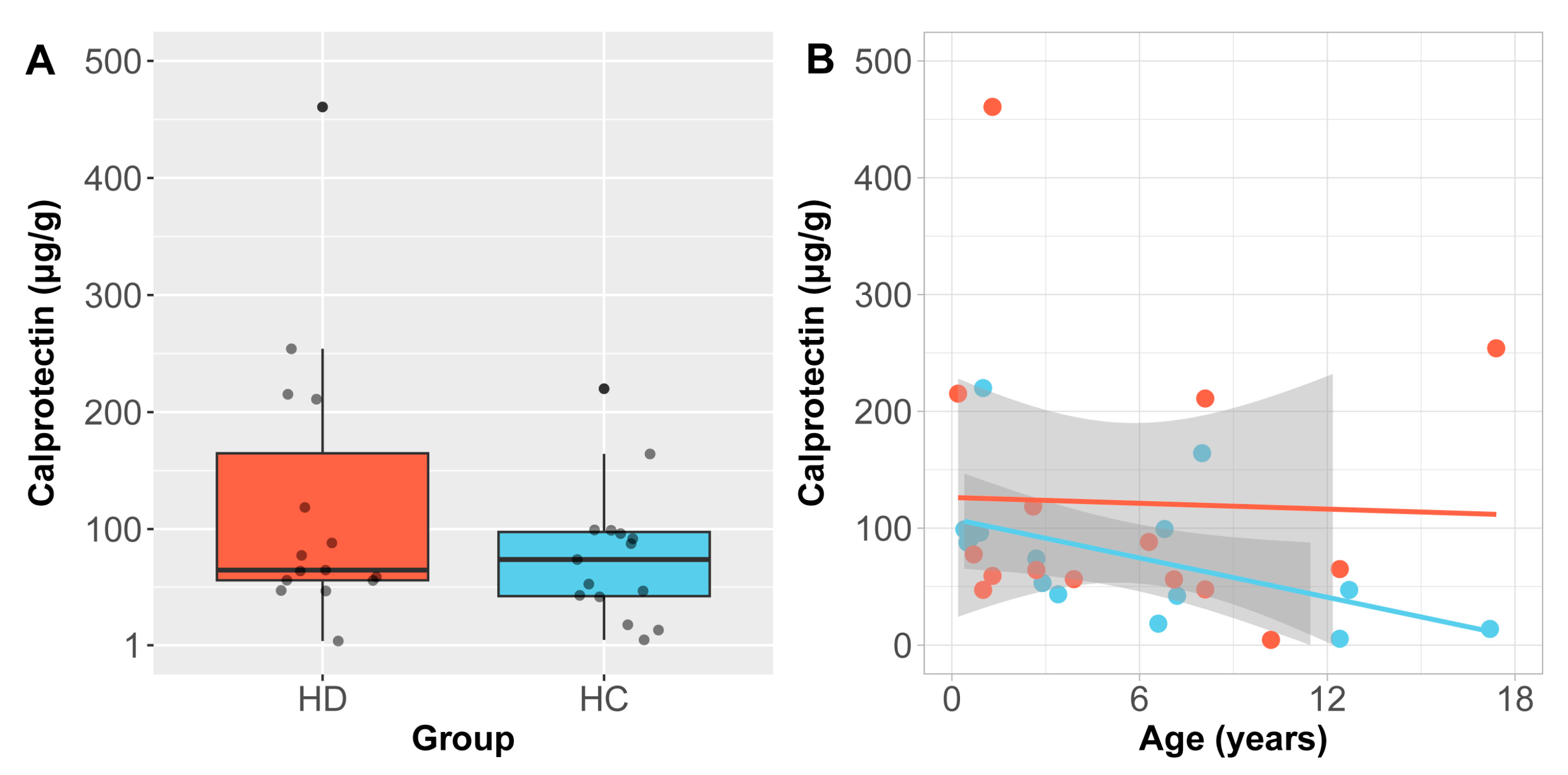Altered Development of Gut Microbiota and Gastrointestinal Inflammation in Children with Post-Operative Hirschsprung’s Disease
Abstract
1. Introduction
2. Results
2.1. Demographics
2.2. Alpha Diversity of the Gut Microbiota Is Unchanged but Does Not Follow the Typical Age-Related Trajectory in Children with HD
2.3. Bacterial Composition of the Gut Microbiota in Paediatric HD Is Unchanged at All Taxonomic Levels
2.4. PedsQL Was Reduced in HD Compared to HC
2.5. Children with HD Show No Overall Increase in the Gastrointestinal Inflammatory Marker Calprotectin
2.6. History of Recurrent HAEC Is Not Associated with Changes to the Microbiota or with Gastrointestinal Inflammation
2.7. Dietary Intake Does Not Differ Between Children with HD and Controls and Is Not Associated with Gastrointestinal Inflammation or Bacterial Abundance
3. Discussion
4. Materials and Methods
4.1. Study Design
4.2. Sample Collection and Analysis
4.3. Clinical Surveys and Analysis
4.4. Statistical Methods
5. Conclusions
Supplementary Materials
Author Contributions
Funding
Institutional Review Board Statement
Informed Consent Statement
Data Availability Statement
Acknowledgments
Conflicts of Interest
Abbreviations
| HD | Hirschsprung’s disease |
| HC | Healthy controls |
| HAEC | HD-associated enterocolitis |
| PedsQL | Pediatric Quality of Life |
References
- Salyer, S.W. Chapter 13—Pediatric Emergencies: A. Emergencies and Resuscitations. In Essential Emergency Medicine; Salyer, S.W., Ed.; W.B. Saunders: Philadelphia, PA, USA, 2007; pp. 652–813. [Google Scholar]
- Arbizu, R.; Nurko, S. Colon: Diseases and Disorders. In Encyclopedia of Food and Health; Caballero, B., Finglas, P.M., Toldrá, F., Eds.; Academic Press: Oxford, UK, 2016; pp. 252–258. [Google Scholar]
- Merrow, A.C.; Hariharan, S. (Eds.) Hirschsprung Disease. In Imaging in Pediatrics; Elsevier: Amsterdam, The Netherlands, 2018; pp. 126–127. [Google Scholar]
- Catto-Smith, A.G.; Trajanovska, M.; Taylor, R.G. Long-term continence after surgery for Hirschsprung’s disease. J. Gastroenterol. Hepatol. 2007, 22, 2273–2282. [Google Scholar] [CrossRef]
- Neuvonen, M.I.; Kyrklund, K.; Rintala, R.J.; Pakarinen, M.P. Bowel Function and Quality of Life After Transanal Endorectal Pull-through for Hirschsprung Disease: Controlled Outcomes up to Adulthood. Ann. Surg. 2017, 265, 622–629. [Google Scholar] [CrossRef] [PubMed]
- Niramis, R.; Watanatittan, S.; Anuntkosol, M.; Buranakijcharoen, V.; Rattanasuwan, T.; Tongsin, A.; Petlek, W.; Mahatharadol, V. Quality of life of patients with Hirschsprung’s disease at 5–20 years post pull-through operations. Eur. J. Pediatr. Surg. 2008, 18, 38–43. [Google Scholar] [CrossRef] [PubMed]
- Dai, Y.; Deng, Y.; Lin, Y.; Ouyang, R.; Li, L. Long-term outcomes and quality of life of patients with Hirschsprung disease: A systematic review and meta-analysis. BMC Gastroenterol. 2020, 20, 67. [Google Scholar] [CrossRef] [PubMed]
- Meinds, R.J.; van der Steeg, A.F.W.; Sloots, C.E.J.; Witvliet, M.J.; de Blaauw, I.; van Gemert, W.G.; Trzpis, M.; Broens, P.M.A. Long–term functional outcomes and quality of life in patients with Hirschsprung’s disease. Br. J. Surg. 2019, 106, 499–507. [Google Scholar] [CrossRef]
- Chantakhow, S.; Khorana, J.; Tepmalai, K.; Boonchooduang, N.; Chattipakorn, N.; Chattipakorn, S.C. Alterations of Gut Bacteria in Hirschsprung Disease and Hirschsprung-Associated Enterocolitis. Microorganisms 2021, 9, 2241. [Google Scholar] [CrossRef]
- Neuvonen, M.I.; Korpela, K.; Kyrklund, K.; Salonen, A.; de Vos, W.; Rintala, R.J.; Pakarinen, M.P. Intestinal Microbiota in Hirschsprung Disease. J. Pediatr. Gastroenterol. Nutr. 2018, 67, 594–600. [Google Scholar] [CrossRef]
- Shen, D.-H.; Shi, C.-R.; Chen, J.-J.; Yu, S.-Y.; Wu, Y.; Yan, W.-B. Detection of intestinal bifidobacteria and lactobacilli in patients with Hirschsprung’s disease associated enterocolitis. World J. Pediatr. 2009, 5, 201–205. [Google Scholar] [CrossRef]
- Arnaud, A.P.; Hascoet, J.; Berneau, P.; LeGouevec, F.; Georges, J.; Randuineau, G.; Formal, M.; Henno, S.; Boudry, G. A piglet model of iatrogenic rectosigmoid hypoganglionosis reveals the impact of the enteric nervous system on gut barrier function and microbiota postnatal development. J. Pediatr. Surg. 2021, 56, 337–345. [Google Scholar] [CrossRef]
- Touré, A.M.; Landry, M.; Souchkova, O.; Kembel, S.W.; Pilon, N. Gut microbiota-mediated Gene-Environment interaction in the TashT mouse model of Hirschsprung disease. Sci. Rep. 2019, 9, 492. [Google Scholar] [CrossRef]
- Ward, N.L.; Pieretti, A.; Dowd, S.E.; Cox, S.B.; Goldstein, A.M. Intestinal aganglionosis is associated with early and sustained disruption of the colonic microbiome. Neurogastroenterol. Motil. 2012, 24, 874–e400. [Google Scholar] [CrossRef]
- Hegde, S.; Lin, Y.-M.; Golovko, G.; Khanipov, K.; Cong, Y.; Savidge, T.; Fofanov, Y.; Shi, X.-Z. Microbiota dysbiosis and its pathophysiological significance in bowel obstruction. Sci. Rep. 2018, 8, 13044. [Google Scholar] [CrossRef]
- Li, Y.; Poroyko, V.; Yan, Z.; Pan, L.; Feng, Y.; Zhao, P.; Xie, Z.; Hong, L. Characterization of Intestinal Microbiomes of Hirschsprung’s Disease Patients with or without Enterocolitis Using Illumina-MiSeq High-Throughput Sequencing. PLoS ONE 2016, 11, e0162079. [Google Scholar] [CrossRef]
- Yan, Z.; Poroyko, V.; Gu, S.; Zhang, Z.; Pan, L.; Wang, J.; Bao, N.; Hong, L. Characterization of the intestinal microbiome of Hirschsprung’s disease with and without enterocolitis. Biochem. Biophys. Res. Commun. 2014, 445, 269–274. [Google Scholar] [CrossRef] [PubMed]
- Garg, M.; Leach, S.; Pang, T.; Needham, B.; Coffey, M.J.; Katz, T.; Strachan, R.; Widger, J.; Field, P.; Belessis, Y.; et al. Age-related levels of fecal M2-pyruvate kinase in children with cystic fibrosis and healthy children 0 to 10 years old. J. Cyst. Fibros. 2018, 17, 109–113. [Google Scholar] [CrossRef] [PubMed]
- Abdel-Rahman, L.I.H.; Morgan, X.C. Searching for a Consensus Among Inflammatory Bowel Disease Studies: A Systematic Meta-Analysis. Inflamm. Bowel Dis. 2023, 29, 125–139. [Google Scholar] [CrossRef]
- Ranjbar, M.; Salehi, R.; Haghjooy Javanmard, S.; Rafiee, L.; Faraji, H.; Jafarpor, S.; Ferns, G.A.; Ghayour-Mobarhan, M.; Manian, M.; Nedaeinia, R. The dysbiosis signature of Fusobacterium nucleatum in colorectal cancer-cause or consequences? A systematic review. Cancer Cell Int. 2021, 21, 194, Erratum in Cancer Cell Int. 2022, 22, 134. https://doi.org/10.1186/s12935-022-02549-3. [Google Scholar] [CrossRef]
- Santoru, M.L.; Piras, C.; Murgia, A.; Palmas, V.; Camboni, T.; Liggi, S.; Ibba, I.; Lai, M.A.; Orrù, S.; Blois, S.; et al. Cross sectional evaluation of the gut-microbiome metabolome axis in an Italian cohort of IBD patients. Sci. Rep. 2017, 7, 9523, Erratum in Sci. Rep. 2018, 8, 4993. https://doi.org/10.1038/s41598-018-23330-5. [Google Scholar] [CrossRef]
- Forbes, J.D.; Chen, C.-y.; Knox, N.C.; Marrie, R.-A.; El-Gabalawy, H.; de Kievit, T.; Alfa, M.; Bernstein, C.N.; Van Domselaar, G. A comparative study of the gut microbiota in immune-mediated inflammatory diseases—Does a common dysbiosis exist? Microbiome 2018, 6, 221. [Google Scholar] [CrossRef] [PubMed]
- Alfa, M.J.; Strang, D.; Tappia, P.S.; Graham, M.; Van Domselaar, G.; Forbes, J.D.; Laminman, V.; Olson, N.; DeGagne, P.; Bray, D.; et al. A randomized trial to determine the impact of a digestion resistant starch composition on the gut microbiome in older and mid-age adults. Clin. Nutr. 2018, 37, 797–807. [Google Scholar] [CrossRef]
- Huizer, V.; Wijekoon, N.; Roorda, D.; Oosterlaan, J.; Benninga, M.A.; van Heurn, L.E.; Rajindrajith, S.; Derikx, J.P. Generic and disease-specific health-related quality of life in patients with Hirschsprung disease: A systematic review and meta-analysis. World J. Gastroenterol. 2022, 28, 1362–1376. [Google Scholar] [CrossRef] [PubMed]
- Coffey, M.J.; McKay, I.R.; Doumit, M.; Chuang, S.; Adams, S.; Stelzer-Braid, S.; Waters, S.A.; Kasparian, N.A.; Thomas, T.; Jaffe, A.; et al. Evaluating the Alimentary and Respiratory Tracts in Health and disease (EARTH) research programme: A protocol for prospective, longitudinal, controlled, observational studies in children with chronic disease at an Australian tertiary paediatric hospital. BMJ Open 2020, 10, e033916. [Google Scholar] [CrossRef]
- McKay, I.; van Dorst, J.; Katz, T.; Doumit, M.; Prentice, B.; Owens, L.; Belessis, Y.; Chuang, S.; Jaffe, A.; Thomas, T.; et al. Diet and the gut-lung axis in cystic fibrosis—Direct & indirect links. Gut Microbes. Gut Microbes 2023, 10, 2156254. [Google Scholar] [CrossRef]
- Hyams, J.S.; Di Lorenzo, C.; Saps, M.; Shulman, R.J.; Staiano, A.; Van Tilburg, M. Childhood Functional Gastrointestinal Disorders: Child/Adolescent. Gastroenterology 2016, 150, 1456–1468.e1452. [Google Scholar] [CrossRef]
- Varni, J.W.; Bendo, C.B.; Denham, J.; Shulman, R.J.; Self, M.M.; Neigut, D.A.; Nurko, S.; Patel, A.S.; Franciosi, J.P.; Saps, M.; et al. PedsQL gastrointestinal symptoms module: Feasibility, reliability, and validity. J. Pediatr. Gastroenterol. Nutr. 2014, 59, 347–355. [Google Scholar] [CrossRef]
- Watson, J.F.; Collins, C.E.; Sibbritt, D.W.; Dibley, M.J.; Garg, M.L. Reproducibility and comparative validity of a food frequency questionnaire for Australian children and adolescents. Int. J. Behav. Nutr. Phys. Act. 2009, 6, 62. [Google Scholar] [CrossRef]
- Fisher, R.A. Frequency Distribution of the Values of the Correlation Coefficient in Samples from an Indefinitely Large Population. Biometrika 1915, 10, 507–521. [Google Scholar] [CrossRef]




| Demographics | HD (n = 15) | HC (n = 15) |
|---|---|---|
| Age (years) | 5.6 (5.0) | 5.6 (5.2) |
| Gender (Male n, %) (Female n, %) | 13 (87%) | 13 (87%) |
| 2 (13%) | 2 (13%) | |
| Weight, age-adjusted z score (SD) n.a. | −0.49 (0.9) | 0.03 (1.3) |
| 2 | 5 | |
| Height, age-adjusted z score (SD) n.a. | −0.75 (1.1) | 0.07 (1.4) |
| 3 | 6 | |
| Affected colonic segment length | ||
| Short n, (%) Long n, (%) | 11 (73%) 4 (26%) | |
| Time since pull-through surgery, yrs (SD) <1 yr 1–4 yrs 5–12 yrs n.a. | 4.7 (4.1) 3 5 6 2 | |
| Recent antibiotics * n, (%) n.a. | 3 (20%) 2 | |
| History of HAEC n.a. | 8 (53%) 2 |
| Age of Respondent | HD | HC | p-Value |
|---|---|---|---|
| PedsQL total score | 83 (11.1) | 93 (9.2) | 0.02 |
| 0–12 months | 83 (13.9) | 85 (11.6) | |
| 13–24 months | 87 (2.2) | 92 (6.7) | |
| 2–4 yrs | 79 (11) | 90 (13.6) | |
| 5–7 yrs | 79 (8.5) | 97 (6) | |
| 8–12 yrs | 86 (7.8) | 98 (2.4) | |
| 13–18 yrs ** | 91 (n.a.) | 97 (n.a.) | |
| PedsQL GI symptoms score | 83 (10.8) | 93 (9.2) | 0.005 |
| 0–12 months | 73 (16) | 89 (13) | |
| 13–24 months | 89 (10) | 91 (7) | |
| 2–4 yrs | 83 (9) | 90 (14) | |
| 5–7 yrs | 80 (7) | 97 (6) | |
| 8–12 yrs | 86 (8) | 98 (2) | |
| 13–18 yrs ** | 91 (n.a.) | 97 (n.a.) |
Disclaimer/Publisher’s Note: The statements, opinions and data contained in all publications are solely those of the individual author(s) and contributor(s) and not of MDPI and/or the editor(s). MDPI and/or the editor(s) disclaim responsibility for any injury to people or property resulting from any ideas, methods, instructions or products referred to in the content. |
© 2025 by the authors. Licensee MDPI, Basel, Switzerland. This article is an open access article distributed under the terms and conditions of the Creative Commons Attribution (CC BY) license (https://creativecommons.org/licenses/by/4.0/).
Share and Cite
Murphy, C.E.; Coffey, M.J.; Chen, Q.; Adams, S.; Ooi, C.Y.; van Dorst, J. Altered Development of Gut Microbiota and Gastrointestinal Inflammation in Children with Post-Operative Hirschsprung’s Disease. Int. J. Mol. Sci. 2025, 26, 10570. https://doi.org/10.3390/ijms262110570
Murphy CE, Coffey MJ, Chen Q, Adams S, Ooi CY, van Dorst J. Altered Development of Gut Microbiota and Gastrointestinal Inflammation in Children with Post-Operative Hirschsprung’s Disease. International Journal of Molecular Sciences. 2025; 26(21):10570. https://doi.org/10.3390/ijms262110570
Chicago/Turabian StyleMurphy, Caitlin E., Michael J. Coffey, Quinlan Chen, Susan Adams, Chee Y. Ooi, and Josie van Dorst. 2025. "Altered Development of Gut Microbiota and Gastrointestinal Inflammation in Children with Post-Operative Hirschsprung’s Disease" International Journal of Molecular Sciences 26, no. 21: 10570. https://doi.org/10.3390/ijms262110570
APA StyleMurphy, C. E., Coffey, M. J., Chen, Q., Adams, S., Ooi, C. Y., & van Dorst, J. (2025). Altered Development of Gut Microbiota and Gastrointestinal Inflammation in Children with Post-Operative Hirschsprung’s Disease. International Journal of Molecular Sciences, 26(21), 10570. https://doi.org/10.3390/ijms262110570






